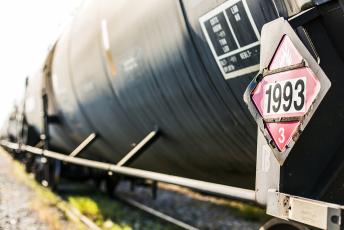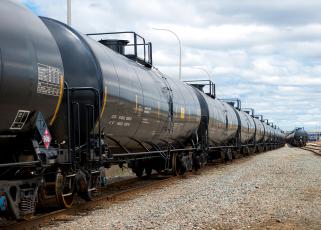Fuels and petrochemicals underpin the global economy. They are essential across industries and households, powering transportation, agriculture, healthcare, technology and most facets of modern life. In light of the recent train derailment in Ohio, there are many questions about why trains are carrying fuels and chemicals and whether they are safe to transport. We completely understand where these questions are coming from and spent some time trying to explain the issue and the role AFPM members, as shippers, play in the safe transportation of materials.
Why do we need to ship by rail?
For a variety of reasons, trains are the best and sometimes only way to ship certain types of critical materials long distances throughout the United States.
Pipelines provide point-to-point transport for certain materials, but not all materials are able to be transported via pipeline. For example, ethanol, which is an essential ingredient in gasoline, cannot move by pipeline and therefore moves most efficiently by rail. Chlorine used in water treatment, likewise, moves predominantly by rail. Butane and other natural gas liquids co-produced with gasoline at refineries are often shipped out from facilities via rail. Rail transport provides flexibility to move materials that pipelines cannot.
Typically, highway transportation is used to ship materials short distances—usually the first or final mile of a journey. Moving critical materials long distances on tanker trucks, however, would be inefficient and add significantly more roadway congestion alongside commuters, which is both less safe and far more logistically challenging. Rail transport can mitigate those concerns.
Where is there government oversight?
The transport of certain chemicals and fuels by rail is regulated by the Department of Transportation (DOT), specifically the Federal Railroad Administration (FRA) and the Pipeline and Hazardous Materials Safety Administration (PHMSA). PHMSA and FRA develop and enforce safety standards for the transport of “hazardous materials” by rail (see definition of a “hazardous material” at 49 CFR Section 171.8). These DOT standards are designed to:
- Prevent derailments from occurring,
- Mitigate or limit the potential impacts if a derailment does occur, and
- Facilitate effective emergency response in the event of a derailment.
DOT regulations cover:
- Inspection protocols (for rail tracks and tank cars) to ensure proper functioning of equipment,
- Labeling and marking requirements to communicate potential hazards to emergency responders and the public,
- Packaging and tank car standards,
- Directives for rail carriers to maintain safety and security plans that include ongoing analyses of rail routes used to transport certain materials,
- Requirements and directions for sharing essential information with emergency responders,
- Instructions for how to organize and order cars on train to mitigate risk, and
- Standards for the safe operation of freight trains (such as speed restrictions for certain trains), among many other requirements.
In addition, freight rail transport is regulated by:
- The Surface Transportation Board (STB) that oversees the economic regulation of freight rail,
- The National Transportation Safety Board (NTSB) that investigates accidents, determines potential causes and then offers recommendations to improve safety,
- The Environmental Protection Agency (EPA) which oversees the environmental remediation and response to incidents,
- The Department of Homeland Security (DHS) and the Department of Defense (DOD), both of which regulate the security of hazardous materials shipments, and numerous other state and local entities.
What are the railroads responsible for and what do AFPM members (and other rail shippers) control?
Transportation safety is a shared responsibility and a range of stakeholders play a part, including rail shippers, rail workers, the railroads (or rail carriers) and well-prepared emergency responders. But let’s take a closer look at shippers and rail carriers:
-
AFPM members, as shippers, control the tank cars and rail cars we own up to the point when we hand them over to the railroads. Today, over 75% of rail cars are privately owned or leased by shippers.
Shippers are responsible for preparing cargoes for pickup and we often load rail cars ourselves, prior to a rail carrier’s arrival. It’s our job to ensure our feedstocks and products are correctly classified and labeled so they’re packaged in the appropriate rail and tank cars. When freight deliveries are received at our facilities, we often handle the unloading of our own rail cars as well.
AFPM members strive to take every measure to make sure our rail cars are safe, whether they’re pressure cars designed to transport gases or tank cars designed to transport flammable liquids like crude oil, ethanol or gasoline. We are held accountable to follow all DOT regulations. In fact, AFPM members and other shippers voluntarily started updating our tank cars in 2011 well before government regulations were adopted in 2015 to require this. To date, almost 100,000 new and retrofitted tank cars have replaced older cars on the tracks. AFPM members have expedited the purchase and retrofit of these cars and have spent billions of dollars ensuring that the cars we entrust to the railroads are safe and well-equipped to transport our products and feedstocks.
AFPM members don’t operate the trains, maintain the tracks or inspect other shippers’ cars. We count on the railroads to do this—to deliver on time and to make deliveries safely.
- Railroads are responsible for loading cars onto trains, safely operating trains and heeding safety warnings, inspecting both rail cars and tracks, overseeing the movement of shipments in transit, maintaining the tracks and analyzing and optimizing freight rail routes, particularly for certain materials (see 49 CFR 215.13 for even more detail on pre-departure inspections). When tracks are correctly maintained, operational safety rules are followed and trains stay on the tracks, AFPM members can say with confidence that our rail cars are safe and that the materials they carry will remain safely inside. Derailments can upend that, and they are unacceptable.
What are common causes of train derailments?
NTSB is currently investigating the specific cause(s) of the derailment in East Palestine, OH, and it is important for that process to be completed before jumping to conclusions about this particular incident or offering policy “solves.”
That said, reducing the frequency of derailments is foundational to rail safety. Additional focus and investments in derailment prevention—including addressing track issues, equipment failures and human error (two of which are the primary causes of most rail accidents)—would certainly help make freight rail transit safer for everyone.
Do we need new policy?
It is rarely helpful to issue policy prescriptions without knowing exactly what happened and what may have caused or contributed to a tragic event like what happened in Ohio. We need to see the outcome of NTSB’s ongoing investigation to determine the causes and contributing factors for this incident. With that clarity, we’ll be able to see whether regulatory changes are needed to address these issues most effectively in addition to a heightened focus on operational behavior. Setting policy prematurely, before basic incident information is confirmed and investigation findings made public, could have unintended impacts.
What else is important to know?
DOT uses various materials classifications to regulate how certain products move by rail.
There are nine different “hazard” materials classes used by DOT and subgroups within those classes. In order to be shipped by rail, materials in the various classes have to be clearly labeled and marked and loaded into specific, highly regulated rail cars. Labeling disclosures and markings provide emergency responders with very key information about the materials in the rail cars should an incident occur. In addition, trains carrying certain “hazard” class materials are required to take additional safety precautions. DOT provides direction on how trains carrying certain materials need to be configured, how fast they’re allowed to travel, what considerations need to be made regarding their transit routes and what additional safety and security plans needs to be in place.
DOT requires specific types of rail and tank cars for certain classes of materials.
- Flammable and other pressurized gases are typically shipped in “pressure cars,” or DOT-105 and DOT-112 tank cars. These cars can be over ½ inch thick and include thermal protection systems with an insulated “jacket” of fiberglass to further protect internal cargo. They have pressure relief devices and protective housings on the top and bottom outlets. The thermal protections and specialized pressure relief devices on DOT-105 and DOT-112 tank cars reduce the risk of overheating in a derailment or other accident scenario.
- Flammable liquids are predominantly shipped in DOT-117R or DOT-117J tank cars. These tanks cars have protective head shields, are thicker than legacy tanks cars, and can include insulated jackets and protective housing on pressure relief valves and handles. A full transition to DOT-117 rail cars for all flammable liquids is underway and proceeding on the incremental, risk-based timeline laid out by DOT (progress is tracked and regularly reported here). This staggered approach is important because there is limited capacity to manufacture new cars and to retrofit older cars to complete the transition.
AFPM members are fully compliant with the transition to DOT-117 rail cars for all flammable liquids.
Per DOT regulations, DOT-117 rail cars are being phased in to take the place of DOT-111 tank cars. AFPM members are fully compliant and are on schedule with this transition, and all our rail cars are routinely inspected. AFPM members, and other shippers, voluntarily began the transition to DOT-117 tank cars years before it was required. We’ve spent billions purchasing new DOT-117 rail cars and retrofitting other cars to the DOT-117 standard—close to 100,000 DOT-117 cars in total.
- Essentially 100% of crude oil transported via rail today moves in DOT-117 rail cars.
- Already, 80% of the ethanol that moves by rail is transported in DOT-117 cars.
- More than 40% of the rail car fleet that transports the rest of the “flammable liquids” class today is DOT-117 rail cars. That percentage will grow until DOT-117 cars are fully adopted according to DOT’s own risk-based schedule. That said, today’s collective fleet of tank cars used to carry the “flammable liquids” class is becoming safer each year.
Freight trains have two common configurations: “unit trains” and “manifest trains.”
- A unit train consists of a large block of tank cars containing a single material like crude oil, ethanol or coal. They carry this one type of cargo long distances from one point to another. PHMSA and FRA’s March 2015 regulation was formulated in response to specific unit train derailments and was designed to address the unique risks of this type of transportation. That rule included new operational requirements, new tank car requirements and created the term “High Hazard Flammable Train” or “HHFT.” The rule explicitly limited the HHFT designation to only apply to unit trains with “flammable liquid” cargos.
- Manifest trains transport a variety of materials in a range of different rail cars. That means a manifest train might carry hopper cars and flat-bed shipping container cars in the same shipment along with DOT-117 cars and pressure cars. DOT regulations specify how many of each type of car are allowed on a manifest train and how the various rail cars need to be separated.
The American Fuel & Petrochemical Manufacturers (AFPM) is the leading trade association representing the makers of the fuels that keep us moving, the petrochemicals that are the essential building blocks for modern life, and the midstream companies that get our feedstocks and products where they need to go. We make the products that make life better, safer and more sustainable — we make progress.


